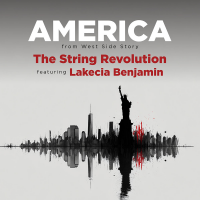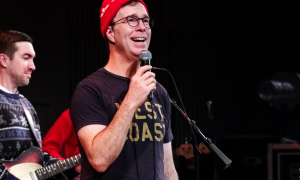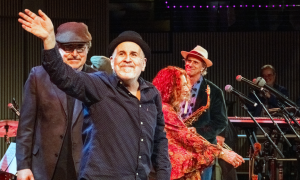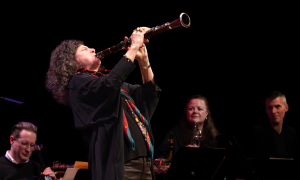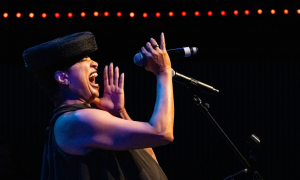Home » Jazz Articles » Live Review » Documenting Jazz 2019
Documenting Jazz 2019
Portraits of Mexican bands such as the Martinez Jazz Orchestra preserved in the Kansas Memory Project reveal instrumentation typical of Kansas City jazz bands of the 1930s trumpet, trombone, sousaphone, piano, banjo, drums, woodwind players. A portrait of the Manuel Corona Band from 1944 shows how the instrumentation had developed, reflecting the popularity of swing, with a rhythm section comprised of bass, piano, guitar and drums, plus three saxophones, three trumpets and one trombone. Unfortunately, it appears that no sound recordings of these bands exist, nor documentation of the audiences they played for.
The embrace of jazz by Mexican bands, Lloyd suggested, was a step towards cultural assimilation, though as documentation was rare and has been poorly preserved, it is difficult to ascertain just what influence Mexican bands played in the development of jazz in Kansas, though that they were active participants, Lloyd said, is seemingly evident. More research on this narrative would be welcome.
The third paper, presented by John Gennari of the University of Vermont, was titled Photographing the Jazz Salon: Clemens Kalischer at Music Inn.
Gennari's paper looked at the photos of Clemens Kalischer, a German-Jewish war refugee who came to New York in 1946. Specifically, Gennari focused on the photos Kalischer took at Music Inn in Lennox, where during the summer months jazz musicians such as Dizzy Gillespie, Dave Brubeck, George Russell, Ornette Coleman and others, along with critics and writers including Marshall Stearns, Nat Hentoff and Langston Hughes, gathered to propagate a formal understanding of jazz.
Their efforts were, according to Gennari, an attempt "to mainstream jazz socially and culturally in post-war America...to evangelize jazz as a force of racial harmony...to sanitize it of its affiliations with political radicalism and racial bohemian subcultures". The Berkshires of western Massachusetts in the post-war years was a thriving centre of literature, summer festivals and tourism, and it was in this landscape that the Music Inn in Lennox existed. Jazz was therefore placed and presented in the context of middle-class cultural tourism.
Gennari presented some of Kalischer's five hundred photos of Music Inn, which showed Marshall Stearns delivering a lecture in 1952 to a small but diverse audience, Connie Kay talking to a student, Gunther Schuller and other intellectual heavyweights teaching jazz history. There was a jazz school where jazz history was taught and there was a concert series. Students, in 1959, included Ornette Coleman and Don Cherry, one photo capturing the former singing Bach chorales.
Clemens died in 2018 aged 97. Curiously, Clemens knew nothing about jazz and actively disliked it, according to Gennari—who got to know the photographer quite well in his final years—and yet the photographer became a very close friend of Ornette Coleman John Lewis and Gunter Schuller. For Gennari, Clemens jazz photography was a blend of art photography and iconography, and very different from other 1950s jazz photographers such as Francis Wolfe, William Gottlieb, Herman Leonard and William Claxton.
Clemens brings an outsider's eye to his photography, clearly recognizing the cultural richness at play when jazz musicians, intellectuals and writers gathered for a leisurely three weeks in the Berkshires. The importance of Clemens' photography, Gennari stated, was because "it can allow us to think about a jazz narrative that moves us away from the classic jazz narrative that is connected to a classic look...".
Jazz and the Digital Age
The digital age has had an enormous impact in how jazz is documented, with YouTube allowing musicians who have never owned a record or CD, who have never been to a jazz concert, to not only access a vast performance and recorded library of music but to learn from the masters [see interview with Vangthanousone Bouaphane: The Lao Jazznova].Jeremiah Spillane of the University of London then delivered a paper titled Documenting 'Gypsy Jazz': Understanding the Posthumous Influence of Django Reinhardt and the Ongoing Interpretation and Codification of His Music Through Pedagogy and Performance Online, which demonstrated how YouTube has been hugely influential in the documentation and dissemination of manouche jazz performance techniques.
Spillane demonstrated how peer to peer exchange of knowledge via YouTube, "the disembodied performance", as he called it, has changed the oral tradition of Gypsy jazz performance techniques. Spillane showed the specialist Gypsy jazz YouTube channel Patrus53.com. The subscription site is run by a Canadian simply known as Patrus. Over eight hundred Gypsy jazz performances, recorded by Patrus around the world, are available to subscribers, as our interviews with the musicians.
The performances are recorded to camera without an audience, with musicians facing the camera so that finger positioning is clear. The success of Patrus 53, Spillane said, makes it a powerful platform for Gypsy jazz musicians the world over, on a promotional and professional level, enabling musicians to reach promoters and gain cultural capital within the scene.
Django Reinhardt is still revered as an innovator in Gypsy jazz and a giant of the genre, but with so little live footage available, and even less of good quality, he is not, Spillane said, the primary source of instruction for today's Gypsy jazz practitioners, who are far more likely to visit Patrus 53 to gain knowledge on the techniques of hundreds of their peers than they are to go to an old Django Reinhardt vinyl or CD. Patrus 53, with its high-quality production values and curation has made it, Spillane said, "an immensely valuable archive and document of styles and approaches to the music at an important time in the Gypsy jazz scene."
If YouTube has to a large degree replaced the LP in jazz pedagogy, then the internet has also enabled jazz Real Books to enter the digital age. The presentation of Tim Nikolsky, jazz guitarist and independent scholar, was titled Digitally Curating the Australian Jazz Real Book. Nikolsky spoke about how his inspiration for the Australian Jazz Real Book came from the jazz Real Book created by students at Berklee College of Music in the 1970s.
In a 2011 interview with All About Jazz, Nikolsky described the process by which the Australian Jazz Real Book developed from a doctoral thesis, the exhaustive selection of songs and the input of many Australian jazz musicians with regards as to what should be included. Five years of toil paid off when the Australian Jazz Real Book was published, in print and on-line in 2013.
Nikolsky summarized the criteria for tune selection in the Australian Jazz Real Book, based on a survey and qualitative interviews with musicians. The book covers over seventy years of Australian jazz, over a hundred and sixty composers and features four hundred songs. But a printed book, Nikolsky said, has no room to expand, except for additional volumes every few years. The digital curation of the Australian Jazz Real Book on the other hand, has all the printed version's tunes and then some, expanding by as many as fifteen tunes per month—by established and emerging artists—and supporting Nikolsy's statement that "Jazz is a living, breathing art form..." .
At the time of this conference the digital Australian Jazz Real Book contained over one thousand, one hundred tunes. The AJRB has been designed, Nikolsky explained, to enable students in Australian music education to play Australian jazz tunes, an option that wasn't previously available in Australian curriculums, as most of the music had never been archived properly. Additionally, the AJRB has profiles of the musicians whose tunes are featured, plus links to their websites, Bandcamp, YouTube and so on.
Nikolsky spoke of Australian jazz's national and regional identities, something promoted by the Wangaratta Festival of Jazz and Blues, where Australian performers participating for the National Jazz Awards must play Australian music. As to the AJRB's effect on the Australian jazz scene, Nikolsky said:"There is a greater awareness amongst the younger generation, because of its availability, because it's been written into curricula. Everyone is checking everyone else out a bit more."
The third paper of the session was presented by José Dias of Manchester Metropolitan University. His paper was titled Documenting the Now and Projecting Ahead: Contemporary Portuguese Jazz in a Multi-Media Platform and Research Resource.
As the Portuguese jazz showcases demonstrated at the European Jazz Conference 2018, in Lisbon, Portuguese jazz is in rude health. Dias's 2016 documentary film Those Who Make It Happen, explored the strength of Portuguese jazz as the fruit of a collective effort by musicians, promoters, audiences and researchers. As Dias outlined in this presentation, that documentary has inspired a project of even greater reach. Jazz +351, Dias explained, is intended as a 12-part web series featuring showcase performances, interviews, discussions and advice on how and where to learn jazz.
Dias' documentary has underlined the Portuguese jazz network, even if, he said, some cannot see it for themselves. Partly inspired by the Improvised Music Company's 12 Points Festival, Dias and Carlos Martin, Festival Director of Lisbon's Festa do Jazz, began to investigate all the different agents involved in a festival to find ways to map the social, artistic and promotional practices at play, including fields such as such as audience experience and the sense of cultural identity.
To this end Dias and Festa do Jazz developed a Researcher-in-Residence programme for three years—a practice increasingly commonplace at European jazz festivals---to promote debate on music education and promotion. Out of this initiative the documentary was created, which in turn was an important element in promoting networking and propelling the creation of the Portuguese Jazz Network.
The next project, Dias outlined, was the above-mentioned Jazz + 321. Taken together, Dias said, these projects, which adopt an interdisciplinary approach encourage informal networks to become formal networks, making something fragile stronger. "We are creating a narrative," Dias concluded, a collective narrative documenting the now..."
Day Three Keynote Speech 2: Gabriel Solis: Seductive? Menace? Revisiting the Place of Recordings in Jazz History
Professor of Musicology and Affiliate in African American Studies and Anthropology at the University of Illinois, Gabriel Solis is perhaps best known for his books Monk's Music: Thelonious Monk and Jazz History in the Making (University of California Press, 2008) and Thelonious Monk Quartet with John Coltrane at Carnegie Hall (Oxford University Press, 2014). His keynote speech centred on the challenges that records present as documents of jazz history. From the outset Solis acknowledged that his paper was inspired in part by Red Rasula's article The Seductive Menace of Records in Jazz History.In a fascinating though somewhat dense and academically heavy paper, Solis invited re-evaluation of the advantages and disadvantages of focusing on jazz records as a way to understand jazz history. Solis revisited notions of the production, circulation and proliferation of recordings as significant markers of the music's history.
One outstanding example offered by Solis was the shift in relationship between musician and record epitomized by Miles Davis and producer Teo Macero's post-production work on albums like Bitches Brew (Columbia, 1970) and On the Corner (Columbia, 1972). On these records the relationship between live and mediated music was challenged. Fast-forward to today and the question, Solis posed, is: how does the material difference introduced by the advent of streaming media condition our understanding of recordings in jazz scholarship? This in turn raises the issue, he said, of how scholars can develop new research methodologies and theories to address the question.
Jazz history, Solis said, is understood through discographic record, through social histories (biography, interviews etc) and through an examination of the music in the cultural context of the USA and the rest of the world. No one filter for understanding jazz is better than another. Instead, Solis argued they should all inform each other. Rasula's key point, taken up by Soils, however, is that jazz history's key document, the record, has largely been overlooked by scholars. Solis suggested that scholars could adopt the critical lenses of media studies, science, technology and ontology to better understand the implications of the record in jazz history.
Solis referred to Professor Tony Whyton's chapter on the Impulse! label in his book Jazz Icons: Heroes, Myths and the Jazz Tradition (Cambridge University Press, 2010) as a good example of mass media, how the marketing, branding—a key jazz strategy—and consumption of a jazz recording plays an important role in the historicizing of jazz. Solis also noted Professor Catherine Tackley's article Jazz Recordings as Social Text, in which she noted scholars' general failure to recognize jazz records as culturally meaningful artefacts that have meanings and uses quite separate to those attributed them by historians.
In the aforementioned paper Tackley had observed how we can listen to the same records as somebody would have fifty or sixty years ago, but that it may mean something very different to us. The historical, geographical and social circumstances of the listener can impart meanings to the music that may be completely at odds with the canonical historicizing of a record by a label [or indeed, a jazz critic]. A more critical assessment of the reception of jazz is needed, Tackley had argued in her article, to appreciate the music's social potential in the 21st century.
Solis touched on a number of other ideas: the technological innovations in sound engineering and how they have impacted upon the record and its reception; the shift in live jazz over the decades towards the contemporary format whereby the record often frames the performance; the concept album, usually attributed to pop and rock, but which has long been a part of jazz history; the way technology drives musicians' ideas; how 'masterpiece' status in jazz depends on mediation.
One of the most revealing parts of Solis' paper addressed YouTube and. Looking at uploads of live videos by McCoy Tyner and Terri Lyne Carrington, Solis spoke of the challenges of using these live recording videos as historical documents (multiple versions of the same concert, inconsistent dates, lack of information on band etc) although they can tell us a lot, for example, about jazz audiences in history and how they became quiet over the decades. The comments posted by viewers also reveals a lot about gender and jazz, with many of the comments on Carrington's videos referencing her sexuality or patronizing her in 'good-for-a- woman'-type comments.
In summarizing Soli's major conclusions, jazz has moved from the 78 and LP to multiple-format historical re-releases and fan-driven, crowd-funded recordings, form the tangible LP to streaming, from audio to YouTube (with its global availability), from print to on-line media. The changes in the production, mediation, reception and social meanings of jazz documents in the twenty-first century require, Solis argued, fresh scholarly approaches to better understand the music's historical narrative.
Biography
In this session three papers shone light on very different figures in jazz history. The first of these was by Yuji Numano of Toho Gakuen School of Music. He delivered a paper titled Free Form as a Symbol of Pluralistic Activities: Youske Yamashita's Artistic Trajectory.Pianist Yosuke Yamashita was arguably the first Japanese jazz artist to become known to European audience, when his trio with Akira Sakata and Takeo Mariyama appeared at major European jazz festivals in 1974, such as Moers, Berlin and Ljubliana. The success of these appearances brought subsequent European tours on an annual basis.
In Japan, before Yamashita, free jazz had been considered as esoteric and marginal. Yamashita's major achievement in Japan, Numano said, was to make free jazz and avant-garde sensibilities more acceptable, and in Yamashita's case, more popular than more mainstream jazz performers.
In response to the free-jazz movement in Europe, the form began to take hold in Japan, as early as 1962. By 1965, Numano noted, Yamashita began his free-jazz trajectory. Seeing John Coltrane in Japan in 1966 emboldened his path in free-jazz. The pianist did not see free-jazz as an art form, Numano related, but as a live act. Quoting Yamashita, Numano related that: " Jazz is like boxing or soccer with sound...".
Yamashita's artistry, however, was multi-faceted. His fame in Japan was due also to his status an essayist, academic and novelist. Yamashita worked with comedians and in 1990 he wrote a science-fiction novel about jazz. Numano showed a video from YouTube documenting one of Yamashita's most famous performances, Burning Piano from 2008, where the pianist, covered in protective clothing, plays the piano on a beach as it is consumed by flames.
Burning Piano was a repeat of a performance Yamashita had enacted in 1973, the film of which is housed in the Museum of Modern Art, New York. Given that Numano highlighted Yamashita's humour as an essayist on jazz, and given the pianist's collaborations with comedians, it's not a stretch to view Yamashita's pyrotechnic free-jazz act as a Monty-Python-esque parody of avant-garde art, though this may also be far from the truth.
From the 1980s, Numano explained, Yamashita's main vehicle, both in the studio and live, was a trio with Cecil McBee and Pheeran akLaff, expanded at times to include Joe Lovano. In Japan, Numano said, jazz has lost some of its former status enjoyed in the 1960s and 1970s as a serious art form, and for many people "jazz is nothing more than mood music played in the bar or restaurant...". In the 1980s when jazz was going off the radar in Japan, Numano related, Yamashita began to appear in the mass media, notably on television, his wit and invention making him a well-known musician in Japan, to the point that for many Japanese 'jazz' meant free-jazz
Yamashita's broad range of artistic outlets, Numano said, were complimentary to his free-jazz, where 'free' meant freedom to express himself as he saw fit. Perhaps one of his greatest achievements, as part of a wider avant-garde circle, was to challenge the rigidness in Japanese society.
The second paper, given by Per Husby of the Norwegian Jazz Archive, was titled Filling in the Gaps: Curating Randi Hultin's 'Biographic' Jazz Collection. The focus of Husby's paper was the internationally renowned Norwegian jazz writer, impresario and enthusiast Randi Hultin (1926-2000). Since 2016, in the Norwegian National Library's jazz division, Husby has been curating, digitalizing and archiving Hultin's private collection of photos, interviews, writings and personal correspondence with jazz musicians.
Husby argued that Hultin's informal, enthusiastic and non-discriminatory approach to jazz and its practitioners, as opposed to a formal, journalist, research- based approach, provided unique insights into the many years Hultin was involved in the jazz scene. Hultin documented things, Husby said, that other journalists didn't see as important at the time. Husby played a rough recording of a ragtime piano recital in Hulton's home by Keith Jarrett from 1966 and showed photos of Jarrett and the rest of the Charles Lloyd band whom she had invited for spaghetti. These were typical of Hulton's documentation, which captured jazz musicians in relaxed mode off-stage.
Hulton's interview technique, or rather her interview manner, was a little rambling and chaotic. She mothered the musicians and told her own anecdotes but, Husby said, the musicians opened up to her in ways they rarely did in more formal, journalistic interviews. The musicians loved Hultin, many of them corresponding with her for years. At least three songs were written in dedication to her by jazz musicians. A Downbeat article from 1971 on Sonny Rollins noted: "Nobody knows where Rollins is...", but in fact Hultin knew, as a photograph she took of Rollins mowing her Oslo lawn attested.
A rare recording of Milton Jackson playing the piano and singing in Hultin's home, another of Coleman Hawkins live in a studio, plus unedited radio recordings and boxes of ephemera including letters, autographed articles, posters etc, are all part of Hultin's private collection that is now archived in the Norwegian National Library. In conclusion, Husby recommended Hulton's autobiography, Born Under the Sign of Jazz, which is published in English.
The third paper in this session was presented by Ted Buehrer of Kenyon College and titled The Radio Broadcast as Jazz Document: Lost Music of Mary Lou Williams. Buehrer argued for the radio broadcast as a highly important and often unique document, citing the example of several Danish National Radio broadcasts in 1968 of the music of Mary Lou Williams.
Buehrer began by emphasizing the important role radio broadcasts played in introducing listeners to the music of their favourite artists during the Swing era of the big-bands. With specific reference to the Danish National Radio broadcasts of Williams' music in 1968, Buerhrer stressed its significance as several compositions featured were the only documented recording of those compositions in Williams' lifetime.
Prior to addressing the radio broadcast in question Buehrer gave a brief description of Williams' career. A fine pianist and leader of her own small combos in New York, Williams was also a talented arranger, writing for Benny Goodman, Earl Hines, Dizzy Gillespie and Duke Ellington, amongst others. Ellington was a great admirer of William's music and Williams wrote numerous arrangements and original compositions for his orchestra in the 1940s. Five of the compositions broadcasted by Danish National Radio on its Williams' tribute programmes were written by Williams for Ellington.
Williams, however, suffered from depression in the next two decades and abandoned her career. She found strength in religion and helped musicians who were addicted to drugs and alcohol through her Bel Canto Foundation. Williams, Buehrer related, returned to her musical career to support her humanitarian work. In the 1960s her career was back on track, though despite writing arrangements for Count Basie and Woody Herman Williams was financially insecure.
The radio shows in question were broadcast in October 1968. The host and narrator was journalist/producer Baron Timme Rosenkrantz, who was opening his own jazz club that month, with Williams booked to play as the opening act. The three shows which lasted between twenty to thirty minutes each, showcased compositions from across Williams' career. Rosenkrantz mentions several Williams' arrangements written specifically for the DNR, but Rosenkkrantz described these comments as inaccurate, saying that the arrangements had been written for Ellington.
Williams had written compositions for Ellington, but an extract from a letter she wrote to Ellington in 1967 seemed to suggest that the music hadn't been commissioned by Ellington. Instead, Williams' wrote the tunes and asked Ellington, if he was interested, for payment. Ellington never paid Williams and, according to Buehrer, probably never played them. Thus, the Danish National Radio Broadcasts of these Williams' compositions are unique documents.
The 1968 DNR broadcasts of Williams' music are archived in The Mary Lou Williams Collection at Rutgers University Library. In 2005, a quarter of a century after Williams' death, these seldom heard compositions were recorded and commercially released by Dutch Jazz Orchestra on Rediscovered Music of Mary Lou Williams (Challenge Records, 2005).
Jazz Events and Identity
The penultimate session began with a paper by Citra Aryandari of the Citra Research Center, Indonesia. Her paper was titled Festivalisation of Jazz in Indonesia: From the Stage to an EventThere are, according to Aryandari, more than two hundred jazz festivals in Indonesia. The number, Aryandari said, came from Indonesia's Ministry of Tourism, although a more reliable figure might be just over one hundred, as claimed by WartaJazz.com in 2018. For almost twenty years WartaJazz.com has been Indonesia's premier jazz agency, founding multiple jazz festivals, promoting national and international concerts and tours and, through its website, providing daily jazz news and reviews.
Whichever figure is closest to the truth it still represents a remarkable growth since the turn of the century when the country had probably fewer than twenty jazz festivals
Jazz festivals in Indonesia are held in both urban and rural areas. In Aryandari's city of Yogyakarta there are three jazz festivals, the longest-standing being the UGM Jazz, which has been running since 1997. Initially known as Economics Jazz, because the festival is held on the campus of Gaja Mada University's School of Business and Economics, ticket prices were too high for many people in the city, Aryandari said.
Ngayojazz, running since 2007, by contrast, mixes jazz and art installation in the village of Gilangharjo. National and international artists representing a wide range of jazz styles share the bill and the festival's posters and communications are written in the local idiom, which makes this festival a more inclusive event. Prambanan Jazz, which held its first edition in 2015 and attracts around twenty thousand people. The festival is held against the spectacular backdrop of Prambanan Temple, a ninth- century Hindu temple and UNESCO World Heritage Site.
Jazz festivals, however, can be found throughout Indonesia, with the honor of the longest-running festival belonging to Jazz Goes to Campus, whose first edition was in 1976. The reasons for the growth and popularity of jazz festivals among Indonesians are several, explained Aryandari. Firstly, tourism. Jazz festivals are seen by the regional authorities as a good way to increase local tourism by promoting an area's natural beauty, with all the economic benefits this brings. Two examples are Jazz Gunung, set in spectacular volcanic mountains in East Java, and Jazz and Dive, a scuba-diving-cum-jazz festival on a remote island off the Indonesian coast of Borneo.
Jazz has a tradition in Indonesia dating back to the 1930s, Aryandari said, but tradition and tourism do not explain the rapid growth of jazz festivals in Indonesia. For many young Indonesians, Aryandari explained, jazz represents modernity and sophistication. It is cool and fun to attend jazz festivals. Jazz festivals exemplify a lifestyle and, Aryandari said, a social mobility.
In summary, Aryandari described how the festivalisation of jazz in Indonesia animates an urban or rural space, influences people's lifestyle, generates economic benefits, improves the image of the host city, town or village, and brings locals, national tourists and foreign visitors alike, together in cultural celebration.
The second paper, titled Documenting Jazz Through Music Competitions: A Belgian Case Study, was presented by Matthias Heyman of University of Antwerp/Royal Conservatoire Antwerp and focused specifically on the B-Jazz International Contest in Belgium, which has been running since 1979, and on how jazz competitions in general can play an important role in documenting and signifying multiple aspects of jazz culture.
For context, Heyman began with a brief history of the jazz competition. Jazz competitions go back as far as the early 1920s in the US, Heyman said, but really grew and expanded in Europe, firstly in the UK with dance band competitions in the mid-1920s. Jazz competitions in Continental Europe began, as far as records show, in the early 1930s. Not even WWII could stop certain competitions and they gained greater momentum from the 1950s on. These days jazz competitions are held throughout the world, embracing diverse formats from big-band to soloist, amateur and professional, local and global.
Although critics deem jazz competitions to be redundant and against the spirit of creating art, nevertheless, the popularity of jazz competitions is indisputable, Heyman asserted, and for this reason they cannot be neglected in jazz literature.
The B-Jazz International Contest, founded in 1979, was originally called Jazz Hoeilaart, after a small town just outside Brussels, and as well as a name change has also relocated to Loeven. Early editions drew bands from across Belgium and The Netherlands but finalists from other European countries soon appeared and as of 2018, B-Jazz International Contest attracts competitors from every corner of the world. The format is open, though typically B-Jazz sees mostly quartets and quintets competing. Six finalists compete and the age limit for participation is thirty years of age.
All genres and styles of jazz are allowed. One Belgium tune is mandatory, though it can be arranged and interpreted in any style. Over the years finalists have been broadcasted on radio and television and the top four recorded on CD, but today there is only live streaming. Participants receive professional audio and video recordings of their performances. Winners get to undertake an international concert tour and, with a view to building networks, get to meet various representatives of the culture industry.
Heyman's recounted how his research into B-Jazz International Contest and the Herbie Hancock Institute of |Jazz Competition (formerly the Thelonious Monk Institute of Jazz Competition) aims to illustrate the relationship between jazz competitions and notions of authenticity, identity, ownership, as well as public reception.
On this latter point Heyman alluded to potentially different public perceptions of jazz competitions as 'high-brow' or 'low-brow,' notions related to the formality of the competition's location, its presentation style, whether there is a monetary award for the winners and the cost of tickets for the public. In the case of B-Jazz International Contest tickets cost seven Euros, compared to $40-$140 for attendance at the Herbie Hancock Institute of Jazz Competition.
From a performative perspective, Heyman noted how choice of repertoire and dress codes (or lack of) are also important signifiers, feeding into narratives of tradition/innovation, high culture/popular music. In conclusion, Heyman said that studying jazz competitions can reveal much about the values and meanings associated with jazz on multiple levels. Heyman's research project into jazz competitions is ongoing.
The third and final paper in this session, presented by Cyril Moshkow of Jazz Ru. Magazine and Russian Jazz Research Center, was titled 1960s Soviet Jazz Live Recordings on Vinyl: An LP Docudrama.
Jazz history in Russia, Moshkow said, began on 1st October 1922 with the first documented jazz concert in Moscow. Thereafter, jazz has had a controversial history in Russia. The focus of Moshkow's paper was a series of LPs released on the Soviet record label Melodiya. Four LPs, Jazz 65, Jazz 66, Jazz 67 and Jazz 68 are highly accessible documents of the Moscow Jazz Festival during those years. Ease of access to these LPs, now half a century old, is because Melodiya printed hundreds of thousands of copies. Many originals still abound in Moscow street markets and record shops, selling for as little as seven Euros.
Jazz in Russia, Moshkow explained, had two beginnings. Firstly in 1922, running until 1946, and then after a nine-year gap when post-WWII the Iron Curtain fell between East and West—and there was very little contact between Russia and western cultures—a reboot in 1955. There resulted, Mishkow said, a cultural gap between jazz musicians of the pre-war and post-war years.
Not only did the jazz musicians of the 1950s play a different jazz to the Russian jazz musicians of the 1930s and 1940s, Mishkow said, but "they sort of despised the older styles of Soviet jazz music as being too Soviet". In other words, the 1950s jazz musicians, reared on Willis Conover's Voice of America jazz broadcasts, were critical of the older generation for playing music that, as they saw it, pandered to popular tastes.
The impact of Willis Conover's nightly broadcasts was immense. As there was no such thing as a jazz curriculum in third level education in Russia until 1974, Conover's jazz programme provided the jazz education for many in Russia and across Eastern Europe, with large numbers of jazz musicians and aficionados recording the broadcasts. "Most of the musicians were classically trained. They had no idea about jazz. They had to figure out the music for themselves", said Moshkow.
Jazz festivals were permitted by the Soviet authorities in 1962, when the first one was held in Moscow. This was a festival and a competition at the same time, Moshkow explained: "The Soviet authorities couldn't think of a jazz festival that wasn't a competition. It must be proven that somebody is better then the others and there are worthy examples that should be followed."
Regarding the LPs, Moshkow described how the two-LP set from the 1965 Moscow Jazz Festival was a fake live recording as Melodiya didn't have the technical capacity to record live concerts at that time. Afterwards, the competition winners dutifully recreated what they had played during the festival for a studio recording, with fake applause added. The subsequent festivals of the next three years were properly recorded live.
Nine of the sixteen bands who played the 1965 Moscow Jazz Festival were included on the studio recordings. The compilation featured only two American jazz standards as the musicians were required to play one piece by a Soviet composer, two originals and possibly one American standard, though musicians were encouraged to write their own tunes. The body of the compositions were typically Russian in tone, based on a popular folk melody, Moshkow said, while the solos were in the bebop and hard bop idioms.
Moshkow presented several photographs capturing the stage and audience of those years, highlighting significant musicians and competition judges. One outstanding musician noted by Moshkow was trumpeter Valery Ponomarev, who left the Soviet Union in the 1970s. He realized an ambition, considered unlikely for a Russian jazz musician at that time, by joining Art Blakey's Jazz Messengers, with whom he made a handful of recordings.
Melodiya continued to record throughout the 1970s, with branches in the Baltic countries of the former Soviet Union, but the four LPs mentioned in this paper remain, Moshkow said, the best documents of the Moscow Jazz Festival between 1965 and 1968.
Lecture Recital: Documenting the Standards
The final slot of the third day of Documenting Jazz offered a further three panels, including panels on jazz journalism and recording jazz. However, it seemed fitting to conclude this coverage of Documenting Jazz with some live jazz.As a jazz pianist and singer, Tish Oney has garnered critical acclaim for her albums such as Forever Friend (Rhombus Records, 2002), Sweet Youth (Bluejazz, 2011) and Songs from the Heart (DGT Productions, 2015). An arranger, Artist-in-Residence and award-winning professor of music at numerous US universities, Dr. Oney is also a high-profile educator and has been writing the Anatomy of a Standard column for All About Jazz since 2016.
In Oney's column for All About Jazz she examines the criteria that constitute a jazz standard, what makes a standard stand the test of time, and how jazz standards are documented from an analytical point of view. For this performative lecture, Oney focused primarily on the analysis of the synthesis of lyrics and music. For Oney, the lyrics of a jazz standard are inseparable from the music in appreciating its value. "When you consider both together a beautiful kaleidoscopic collision often occurs", Oney said. For Oney, as for the great song-writing teams, lyrics and music are integral to the appeal of jazz standards.
Oney presented five songs from her Anatomy of a Standard column, illustrating the harmonic patterns, the melodic contours, the themes inherent in the lyrics, the source and style of the lyrics and rhyme patterns. Oney began, however, with a fluid scat that led into a vocal-only version of the Jerome Kern/Dorothy Fields' song "Pick Yourself Up," a song she typically opens or close her concerts with. Oney then demonstrated how the lyrics and music perform the same mission to uplift the listener and how the bridge harmony and melody propel the music forward.
It was fascinating to listen to Oney musically dissect and signpost where musical and lyrical phrases align and where the diverge, how the rising-falling melodic and harmonic contours of Bernice Petkere's "Close Your Eyes" suggest the motion of a pendulum or rocking cradle, on what is a lullaby, or how classical and jazz elements combine on Duke Ellington/Irving Gordon/Irving Mills' "Prelude to a Kiss"—a song Oney described as technically very challenging for singers.
On Fats Waller/Andy Razaf's "Ain't Misbehavin'" and Jimmy Van Heusen/Johnny Burke's ""Here's That Rainy Day," Oney highlighted rhyme patterns, use of tension and release, and balance between text and music. Analysis aside, Oney's vocal phrasing, notably on "Prelude to a Kiss" and "Here's That Rainy Day" and her elegant, nuanced piano playing was simply delightful.
In conclusion, Oney advocated the dual analysis of music and lyrics when considering the jazz standards to create better informed performing artists and jazz scholars alike. In addition, Oney said, We spread awareness of what a total work of art these songs really are.". Studying jazz standards can help modern song- writers create enduring works, because, Oney said, "these recipes haven't failed."
Tags
PREVIOUS / NEXT
Support All About Jazz
 All About Jazz has been a pillar of jazz since 1995, championing it as an art form and, more importantly, supporting the musicians who make it. Our enduring commitment has made "AAJ" one of the most culturally important websites of its kind, read by hundreds of thousands of fans, musicians and industry figures every month.
All About Jazz has been a pillar of jazz since 1995, championing it as an art form and, more importantly, supporting the musicians who make it. Our enduring commitment has made "AAJ" one of the most culturally important websites of its kind, read by hundreds of thousands of fans, musicians and industry figures every month.













